Intelligent lighting control has revolutionised the way we think about lighting systems. With the ability to customise and optimise lighting solutions to meet the specific needs of each space, intelligent lighting control can enhance the efficiency, comfort, and convenience of your home or business.
One of the key benefits is energy efficiency. By programming your lighting system to turn off when not in use or adjusting the lighting levels based on the time of day, you can significantly reduce energy usage and lower your electricity bill. This not only saves you money but also helps to reduce your carbon footprint.
What is Intelligent Lighting Control?
Intelligent lighting control refers to a lighting system that is automated and controllable through a centralised system. It allows for the customisation of lighting scenes, scheduling, and programming, allowing you to adjust the lighting in your space according to your needs and preferences.
It is designed to provide maximum efficiency and convenience. The lighting system can be programmed to automatically turn on and off at specific times, or based on occupancy or motion sensors. It can also be controlled remotely via a smartphone or tablet, allowing you to adjust the lighting from anywhere.
What are the benefits of Intelligent Lighting Control?
Intelligent lighting control offers a wide range of benefits for both residential and commercial properties. Here are some of the key benefits:
- Energy efficiency: With intelligent lighting control, you can program your lighting system to turn off when not in use, adjust lighting levels based on the time of day, and even use motion sensors to detect when a room is unoccupied. This helps to reduce energy usage and lower your electricity bill.
- Customisability: With intelligent lighting control, you can create custom lighting scenes and adjust lighting levels to meet the specific needs of your space. Whether you’re looking to create a relaxing ambiance or a productive work environment, intelligent lighting control allows you to tailor your lighting system to your preferences.
- Increased comfort: With the ability to adjust lighting levels and colors, you can create a lighting system that enhances the comfort and ambiance of your space.
- Improved security: Intelligent lighting control can be integrated with your security system to enhance your home or business security. With the ability to program your lighting system to turn on and off at specific times, you can create the illusion of occupancy even when you’re away.
- Productivity: In a commercial setting, intelligent lighting control can be used to enhance productivity by creating a lighting system that supports a specific work environment. For example, you can program your lighting system to adjust lighting levels based on the time of day or to create a more focused work environment.
Light Scenes
A lighting scene refers to a pre-set configuration of lights in a particular space that is designed to create a specific ambiance or mood. A lighting scene can be created using an intelligent lighting control system, which allows for customised control over the lighting in a space.
For example, a lighting scene could be created in a space to create a cosy atmosphere. This scene may involve dimming the lights to a low level and selecting warm color temperatures to create a comfortable and relaxing environment. Similarly, a lighting scene in a work area may involve setting the lights to a brighter level and cooler color temperatures to create a bright and productive environment.
Lighting scenes can also be used to highlight particular areas of a space, such as artwork or architectural features. This is achieved by adjusting the intensity and direction of the lights to create a dramatic effect that draws attention to the focal point of the space.
Overall, lighting scenes provide an easy and convenient way to customize the lighting in a space to fit specific needs and preferences. They can be easily programmed into an intelligent lighting control system and activated with the touch of a button or through a schedule, making it simple to switch between different lighting scenes as desired.
BMS Integration
Integrating intelligent lighting control systems with building management systems (BMS) can enhance the overall functionality and efficiency of a building’s lighting system. This integration allows for centralised control and monitoring of lighting systems, as well as more advanced automation capabilities.
Intelligent lighting control systems use sensors and controllers to regulate lighting levels based on occupancy, daylight, and other environmental factors. By integrating these systems with a BMS, the lighting can be integrated with other building systems such as HVAC, security, and fire safety systems to create a unified and interconnected building ecosystem.
One benefit of BMS integration is increased energy efficiency. The BMS can monitor and adjust lighting levels in response to occupancy patterns, daylight levels, and other environmental factors. This can lead to reduced energy consumption and lower utility bills, as well as a smaller carbon footprint for the building.
Another benefit of BMS integration is improved maintenance and troubleshooting capabilities. By centralising control and monitoring of the lighting system, maintenance personnel can quickly identify and address issues with the lighting system, reducing downtime and minimising disruptions.
BMS integration can also enable more advanced automation capabilities for the lighting system. For example, the BMS can automatically adjust lighting levels based on time of day, occupancy patterns, or other criteria. This can enhance the comfort and productivity of building occupants, as well as improve the overall aesthetic of the building.
- Lighting Control
- Façade Automation – blinds, solar control, windows, natural ventilation
- HVAC
- Energy Metering and Management
- Security and Monitoring
- Audio-Visual Control and Interfacing
- Touch Screen and Visualisation Interfaces
- IP Connectivity and Remote Access
- Interfaces to many other third-party systems and protocols
DALI Lighting
DALI (Digital Addressable Lighting Interface) lighting is a popular lighting control protocol that allows for digital communication between lighting fixtures and control devices. When combined with intelligent lighting control systems, DALI can provide a highly customizable and energy-efficient lighting solution for commercial and industrial buildings.
Intelligent lighting control systems use sensors and controllers to regulate lighting levels based on occupancy, daylight, and other environmental factors. By integrating DALI lighting with these systems, lighting levels can be adjusted in real time based on a variety of factors, including the presence of people in a space and the amount of natural light available.
DALI lighting also offers advanced functionality, such as individual dimming and control of color temperature. This allows for greater customization and control of lighting levels and color temperature in a space. Intelligent lighting control systems can take advantage of this functionality to create lighting scenes that are tailored to specific activities or times of day.
Another advantage of combining DALI lighting with intelligent lighting control is increased energy efficiency. The system can monitor and adjust lighting levels in response to occupancy patterns, daylight levels, and other environmental factors. This can lead to reduced energy consumption and lower utility bills, as well as a smaller carbon footprint for the building.
By combining DALI lighting with intelligent lighting control, building operators can achieve greater energy efficiency, improve comfort and productivity for building occupants, and create a more flexible and customisable lighting system. This makes it an ideal solution for commercial and industrial buildings where lighting control is a critical component of building operations.
- Precise control
- Energy efficiency
- Flexibility
- Advanced functionality
- Cost savings
- Improved occupant comfort and productivity
Why install an Intelligent Lighting Control System?
Overall, integrating intelligent lighting control systems can enhance the functionality, efficiency, and automation capabilities of a building’s lighting system. By centralising control and monitoring of the lighting system, building operators can achieve greater energy efficiency, improve maintenance and troubleshooting capabilities, and create a more comfortable and productive environment for building occupants.
KNX is an intelligent solution for networking and controlling building technology. It has been established for over 32 years and is a worldwide standard for home and building control, adopted by Standards Australia as a technical specification.
KNX is the world’s only truly open protocol endorsed by worldwide standards. KNX is not manufacturer specific. It is open protocol and all aspects are managed by the KNX Association in Brussels. KNX requires all products to undergo stringent independent testing and verification before approval and the logo application is allowed.
The topology has no limit to the size and scale of the buildings in which it can be used. It is equally well suited to large scale commercial projects as to a residential building.
Manufacturers
There are over 495 manufacturers and 8,000 approved products. Many the world’s leading electrical brands offer KNX building control and automation solutions.
Including:












You are not tied down to using one manufacturer. All certified products are interoperable, and backwards compatible. With this approach the system will never become obsolete as there is always an upgrade path to follow.
KNX is the perfect choice for a complete integrated project and provides not just lighting control but a total solution for your building control system.
Applications
KNX solutions are used across an extremely wide range of building control and automation applications across all market segments including commercial projects, industrial buildings, and residential home automation. It is highly flexible and is typical for the system to be used across many different applications within the one project.
Such applications include:
- Lighting Control
- Façade Automation – blinds, solar control, windows, natural ventilation
- HVAC
- Energy Metering and Management
- Security and Monitoring
- Audio-Visual Control and Interfacing
- Touch Screen and Visualisation Interfaces
- IP Connectivity and Remote Access
- Interfaces to many other third-party systems and protocols
KNX is extremely powerful when interfacing with other systems and protocols as there are many established gateways from numerous suppliers. These include OPC Servers, SCADA, BACnet, DALI and others. These interfaces and gateways are commonly used all over the world and have been tried and tested.
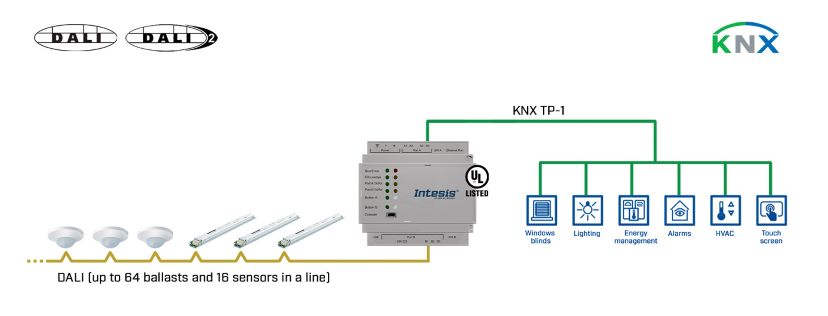
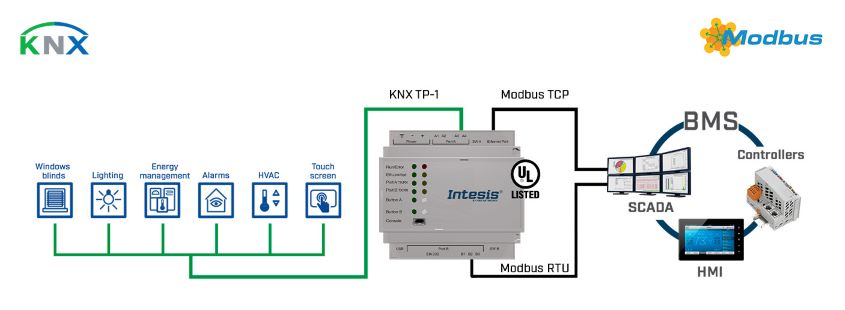
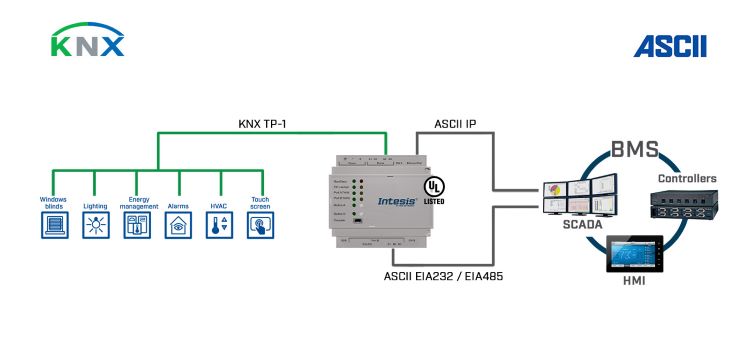
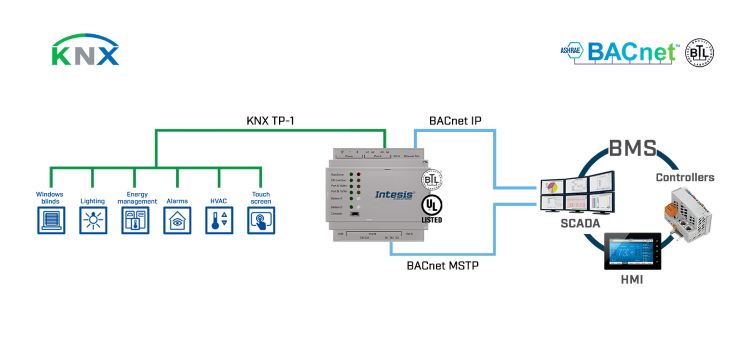
KNX Topology
The topology is arranged in lines that can be interconnected via couplers depending on the size of the network. The devices on the bus lines (sensors and actuators) are supplied with energy by a power supply (30VDC). The entire bus system can be configured with more than 50,000 bus devices.
The KNX structure is very flexible in its design: linear, tree and star wiring configurations are allowed.

A typical installation will consist of a control panel designed to house the power supplies and other DIN rail mounted devices. The control panel will be sized to suit the project. It is a modular system, the components are selected depending on the requirements of the project.
The bus cable is immune to noise and is designed to be installed along side 240V cabling. This means there is no need for additional cable support structures.
KNX installations can use several physical communication types:
- Twisted Pair (TP)
- Powerline
- Radio Frequency
- IP
Typical KNX Projects
- Office Buildings
- Hotels
- Residential Buildings
- Education
- Hospitals
- Industrial
- Stadiums
- Correctional Centres
- Defence
Benefits
- Open protocol – end client has full access
- Worldwide standard over 32 years
- Reduced site installation time
- Not tied to one specific manufacturer
- Less cabling required
- Data can be passed from one application to another
- Efficient installation, one integrator, one system
- Applications can share devices
- Increased levels of control and functionality
- Standard commissioning procedures
- Increased energy efficiency
- Flexible and fully upgradeable
- Enhanced user experience focused
- Backwards compatibility
- Reduced maintenance required
- Reduced number of devices on the wall
We are proud to be a member of the KNX community and integrator of KNX products and systems. We value the importance of open protocol and adoption of automation technical standards.
Businesses operate with complex electrical systems in place. From energy and staff efficiency to the personnel and facility safety, electronics play a valuable part in a building’s infrastructure. When these electrical systems in place are unmaintained or overlooked, more than just time and money can be at risk. A maintenance electrician is a valuable resource businesses can use to conduct routine inspections of these electrical systems.
Employee safety and productivity are naturally high priorities in any workplace. Businesses rely on their equipment running efficiently. Poor electrical maintenance can lead to more than just a minor interruption. When left unattended, these systems have the potential to cause severe electrical issues. This can affect the operation of your business or may even cause injury or property damage.
Electrical Compliance
The best way for a business to avoid electrical faults and reduce risk to its employees and customers, is to have an electrical maintenance plan in place. In October 2017, Queensland introduced a new criminal WHS offence of ‘Industrial Manslaughter’. These provisions make it an offence for a person conducting a business or undertaking (PCBU), or a senior officer, to negligently cause the death of a worker.
Poor electrical maintenance and faulty electrical systems can:
- Lead to the risk of electric shock
- Enable unsafe working conditions
- Prevent safe evacuation during an emergency
Electrical compliance is often overlooked by businesses. These include Emergency Light Testing, RCD Testing, Test & Tag, and Electrical Thermal Imaging.
Emergency Light Testing
Emergency and exit lighting must be inspected, tested, and maintained in accordance with the AS/NZS 2293 Standard. Commercial emergency lighting and exit lighting systems are governed by the law.
All emergency and exit lights must undergo a 90-minute discharge test of the battery every 6 months. As stated under the AS2293.2 Standard. Records of all tests and the subsequent actions taken must be kept for compliance purposes.
RCD Testing
A residual current device (RCD), commonly known as a safety switch Is a device that prevents dangerous electrical shocks from occurring.
Residual current devices need to be regularly tested to ensure they remain in correct working order. They will only provide ongoing protection if operational. The frequency of their testing is outlined in AS/NZS 3760 Table 4. This table outlines the in-service safety inspection, testing method and frequency.
Test and Tag
Test and tag is the process of inspecting and testing electrical equipment for safety. This is in accordance with the test & tag frequencies outlined in the AS/NZS3760 Standard.
The process for test and tag is completed in two stages. First the equipment is visually inspected for any damage, then it is electrically tested to ensure there are no internal faults.
Thermal Imaging – Infrared Thermography
Thermal imaging can find hot spots caused by loose connections and defects in components. It detects problem areas so that failure or damage can be avoided ahead of time.
Industrial Power and Automation uses the latest technology in scanners. Which can detect electrical faults often missed by traditional methods of testing.
We are certified in Thermographic Scanning and our qualified technicians are recognised by the Australian Institute for Non-destructive Testing (AINDT).
In addition to electrical compliance issues, lack of electrical maintenance can:
- Cause the need for expensive repairs
- Create unnecessary downtime
- Reduce asset life
- Reduce energy efficiency
When is it time to call a maintenance electrician?
The best time to call an experienced maintenance electrician is before something has gone wrong. Some examples of when to call is:
- If you haven’t had maintenance completed in the previous 12 months.
- The business or school doesn’t have an established preventive maintenance plan in place.
- There is a need for a new switchboard or upgrade of an existing one.
- There are broken or faulty fittings.
- There are broken or exposed wires in view.
- Regularly used appliances test tags are out of date.
- Emergency lighting in the business or school is not functioning.
- The holidays are approaching and there’s an available opportunity for a scheduled shutdown.
- There is an incorrectly completed or no maintenance logbook in place.
- Access or walkway lights have been broken or disabled.
The failure rate of electrical equipment is three times higher for components that are not part of a scheduled maintenance program as compared with those that are. In addition, a planned electrical maintenance program allows the equipment owner to schedule the system outage at a time of their choosing rather than having to correct major problems resulting from an always untimely failure.
Performing preventive maintenance prolongs the life of your assets and equipment, reduces downtime, decreases reactive maintenance calls, helps you manage compliance, and prevents costly emergency repairs from occurring.
Contact a Maintenance Electrician
Our maintenance electricians offer extensive services for our clients. Servicing Brisbane, Logan, and the Gold Coast. We can schedule maintenance services based on your budget, needs and compliance requirements. Our management software can log your assets and keep a detailed record of their service history, as well as send reminders when the next inspection is due, leaving you to focus on what’s important.
We specialise in electrical building maintenance for large commercial buildings, factories, shopping centres, offices, and body corporate buildings. Partnering with building management professionals, property managers, asset managers and facilities maintenance organisations, IPA provides scheduled and reactive services to business from Brisbane to the Gold Coast.
- Exit & Emergency Lighting Testing
- Test & Tag
- Thermal Imaging / Thermographic Scanning
- RCD Testing
- VSD Testing & Maintenance
- Power Factor Correction Unit Inspections & Maintenance
- Switchboard Maintenance and Inspections
- Fault Diagnosis
- Power Outlet Installation & Replacement
- General Lighting Installation & Replacement
- Lighting Control
- Globe & Lamp Replacements
- Compliance Inspections
- UPS Service & Testing
- Generator Testing & Maintenance
- Air Circuit Breaker Testing
- Energy Efficiency: Power Factor Correction, LED Lighting
- Data Cabling Installation & Repair
Contact us today to have us schedule electrical maintenance in your building.
Industrial Power and Automation specialises in electrical building maintenance for large commercial buildings, factories, shopping centres, offices, and body corporate buildings.
Partnering with building management professionals, property managers, asset managers and facilities maintenance organisations, IPA provides scheduled and reactive services to business from Brisbane to the Gold Coast.
Our highly skilled team of electricians can take care of all your electrical building maintenance and electrical inspection requirements no matter how big or how small your business is.
Performing preventive maintenance prolongs the life of your assets and equipment, reduces downtime, decreases reactive maintenance calls, helps you manage compliance, and prevents costly emergency repairs from occurring.
The failure rate of electrical equipment is three times higher for components that are not part of a scheduled maintenance program as compared with those that are. In addition, a planned electrical maintenance program allows the equipment owner to schedule the system outage at a time of their choosing rather than having to correct major problems resulting from an always untimely failure.
Commercial & Industrial Electrical Building Maintenance
IPA provides technical expertise in the areas of commercial electrical contracting, leading in all aspects of electrical maintenance services, including the development of asset management and strategies for individual sites, to provide you with the best possible solutions for your building’s requirements.
Facility Maintenance
No matter what the issue is or what electrical issue may arise, IPA have the knowledge and facilities to complete thorough electrical analysis, routine servicing of controls and components, testing and repairs, fault diagnosis, electrical maintenance, testing and tagging, routine servicing, repairs of all electrical components and replacement of electrical systems.
Electrical building maintenance offers a variety of benefits:
- Less equipment downtime
- Fewer interruptions to critical operations
- Longer asset life
- Improved efficiency
- Increased workplace safety and improved compliance with OSHA
Industrial Power and Automation provides an extensive range of electrical building maintenance services for our clients. We can schedule maintenance services based on your budget, needs and compliance requirements. Our management software can log your assets and keep a detailed record of their service history, as well as send reminders when the next inspection is due, leaving you to focus on what’s important.
Electrical Maintenance Services:
- Exit & Emergency Lighting Testing
- Test & Tag
- Thermal Imaging / Thermographic Scanning
- RCD Testing
- VSD Testing & Maintenance
- Power Factor Correction Unit Inspections & Maintenance
- Switchboard Maintenance and Inspections
- Fault Diagnosis
- Power Outlet Installation & Replacement
- General Lighting Installation & Replacement
- Lighting Control
- Globe & Lamp Replacements
- Compliance Inspections
- UPS Service & Testing
- Generator Testing & Maintenance
- Air Circuit Breaker Testing
- Energy Efficiency: Power Factor Correction, LED Lighting
- Data Cabling Installation & Repair
Contact us today to have us schedule electrical building maintenance in your building.
This article covers how often emergency lighting needs to be tested, per the Australian government’s rules and regulations.
It is a requirement, as governed by law, for emergency lighting and exit signs to be installed in all commercial buildings and multi-residential buildings. These must be regularly tested to comply with the fire safety regulations outlined in the Australian Standard 2293 – Emergency escape lighting and exit signs.
But how often does emergency lighting need to be tested? Here is what you need to know about emergency lighting and exit sign testing and its various requirements.
Industrial Power and Automation is an electrical contracting business specialising in industrial and commercial electrical solutions for manufacturing businesses & clients in industrial environments. We are a local, trustworthy company based in Southeast Queensland, servicing Brisbane and the Gold Coast. If you need emergency light testing, contact us today.
Emergency & Exit Light Testing Requirements
In order to comply with fire safety regulations outlined in AS 2293, emergency and exit light testing must be done every 6 months by a licensed fire safety technician. As part of the 6 monthly tests, all emergency and exit lights must undergo a 90-minute discharge test of the battery. Records of these tests must also be kept for compliance purposes.
Every 12 months, your emergency lighting and exit signs will also need to undergo an annual test by a fire safety technician. This covers the 6-month test and an additional inspection and cleaning of the fittings and reflective surfaces on any emergency lighting and exit signs.
In the event of an emergency, non-compliant emergency lighting and exit signs could expose your building’s occupants to a high risk of danger and the consequences could be fatal.
What Are Emergency Lights And Exit Signs?
Emergency lights provide lighting in a building during an emergency. Emergency lights are an important safety feature in any building and they can help to prevent accidents and injuries in the event of a power outage.
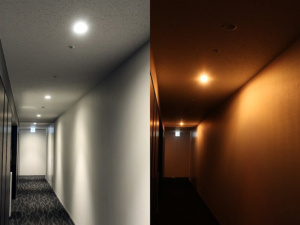
Exit lights are used to direct the occupants of a building to the nearest emergency exit. Exit lights must be clearly visible and illuminated at all times.
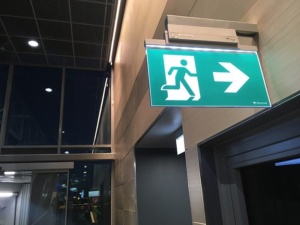
Emergency lights and exit signs will run off of your building’s main power, but they also feature back-up batteries in the event where the main power is cut off. This is why it is vital to ensure your emergency lighting and exit signs are regularly tested.
Who Can Test Emergency Lighting & Provide Me With An Emergency Light Testing Certificate?
Only a licensed fire safety electrician or technician can test emergency lighting and exit signs. At Industrial Power and Automation, our electricians are qualified to perform emergency lighting and exit sign testing. After testing your emergency lighting, our electricians will provide you with an emergency light testing certificate that will detail your compliance to the regulations.
Contact us today to have us inspect the emergency lighting and exit signs in your building and ensure they are compliant with the law.
Industrial Power and Automation can assist with variable speed drive installation, replacement, or retrofits.
What is variable speed drive (VSD)?
Variable speed drives (VSD) are sometimes called Variable Frequency Drives (VFD) or AC drives.
A variable speed drive is a device which helps regulate the speed of a motor by varying the electrical supply. Variable speed drives sit between the electrical supply and the motor. Power from the electrical supply goes into a drive which then regulates the power that is fed to the motor.
Variable speed drives are constructed in a way that makes them highly efficient. VSD’s adjust the frequency and the voltage that feed into to the motor based on your current process demands. This means you run your AC motors at the speed or with the torque according to the demand needed.
It is estimated nearly 70 percent of all industrial electrical energy use goes into powering electric motors. Running these applications with variable speed drives results in instant savings in energy consumption while it also brings long-term competitive advantages.
5 benefits of variable speed drives
- Improved Energy Savings
Variable speed drives use only the required amount of energy by running the motor at partial load. This results in a significant reduction in energy consumption of a motor control system. Starting Currents in VSDs are less compared to a conventional drive system as the speed can be gradually increased. - Increased Manufacturing Efficiency
Manual labour is eliminated as the system controlled by drives can easily be automated. VSD speed control allows you to run at a pre-determined product output. Because of a wide range of control, VSDs assist in improving the quality of the manufacturing system. - Savings in Capital Expenditure
The immediate reduction in power consumption ensures fast payback a variable speed drive installation. For larger applications this can happen within months of installation. Savings are also achieved through the elimination of expensive mechanical drive components - Savings in Maintenance Costs
VSD’s increase motor longevity. They reduce the risk of motor damage during start up and stopping. The stress on the mechanical equipment during start-up and operation can be minimized ensuring longer lifetime of the equipment. VSD’s also record detailed fault logs, which your maintenance team can use for future preventive maintenance. - Better Process Control
With better speed control, variable speed drives allow you to ramp up or down operations as needed. Motors can be automated to run at precise speeds or to stop at an exact position.
These type of valuable gains can be achieved not only in large industrial operations but also in smaller installations as well. Variable speed drives also record real-time motor data. Which can then be displayed on your local HMI panel or SCADA system. This allows you to monitor motor rpm, frequency, current, voltage & running status. As well as keeping a detailed record of fault history.
Variable Speed Drive Installation Gold Coast
Industrial Power and Automation is experienced in variable speed drive installation, replacements, and retrofits. We can integrate the variable speed drive with your existing automation system or install as a stand-alone unit. We will select the best VSD to suit your needs or install a site-specific brand if preferred.
You can contact us today, and rest assured that you will get the best electrical services no matter your industry.
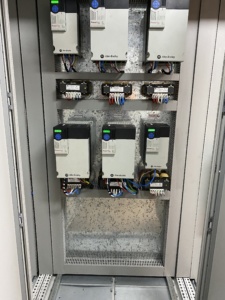
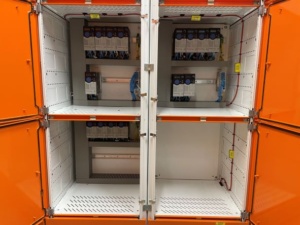
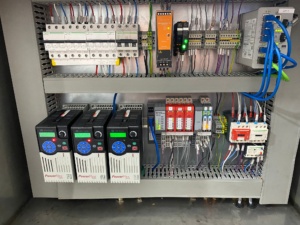


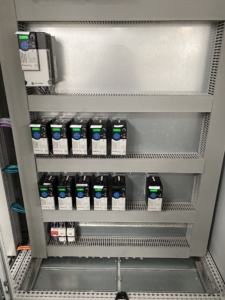
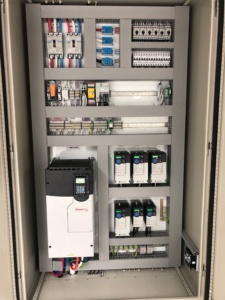
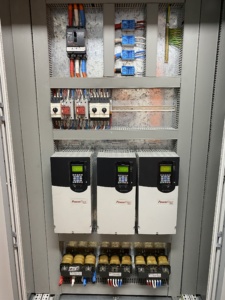
Electrical Control Panel Builder
As an electrical control panel builder, we are responsible for the construction of electric control panels for manufacturing machinery and other various types of industrial, mining, or agricultural equipment. Control panel builders normally work for their customers directly. However in some cases the panel builder may be part of a large installation team or build directly for an equipment manufacturer.
What is an electrical control panel?
An Industrial electrical control panel is an assembly of components. Such as circuit breakers, variable speed drives, relays, PLC’s and other motor control equipment installed together in an enclosure. They are used in various applications including; the operation of industrial electric motors, pumps and drives, production machinery, and assembly and conveyance equipment.
Another form of electrical control panel is the Motor Control Centre or MCC. Which includes all the motor starting and control equipment to drive plant equipment and machinery. Industrial electrical control panels contain power circuits, control circuits or a combination of both. Saving space in control panel applications is always a factor. Panels are designed with devices positioned to use as little space as possible.
Industrial manufacturing processes and production lines require that electrical control panels; protect equipment, increase productivity, reduce down-time, and meet all current safety regulations. Industrial electrical control panels control all important manufacturing equipment. As well as provide a single point of operations for the control of an entire manufacturing process.
What can you expect from IPA?
Industrial Power and Automation will support you with control panel design, fabrication, and installation. As an electrical control panel builder we design, build, and install basic or complex control panels. Our panels control motors, conveyors, machinery, or manufacturing lines.
We design, build, and install; Electrical Control Panels, MCC Panels, Remote I/O Panels, HMI Panels, PLC Control Panels, and Push Button Stations. We will design the control panel to suit your needs. Whether you need stainless steel, hygienically designed, or a specific brand of control equipment.
An experienced in-house team
We design & build all of our control panels in-house. Our amazing team has a wealth of expertise in this field. The unique capabilities of our in-house team allow us to supply electrical control panels that will perfectly satisfy your requirements. Our team will meet the specific project criteria and customize the perfect electrical control panel for you.
Local Technical Support
Our work isn’t finished after providing you with a custom electrical control panel. We will continue to support your business with the assistance of our expert technicians whenever an issue arises with any of your equipment or machinery. Our experienced in-house team will be available to provide you with real-time support 24/7.
Quality Assurance
After the electrical control panel build is complete, we carry out quality control testing. This is known as a ‘Factory Acceptance Test’ in the electrical industry.
This is where we complete a visual inspection of the panel to ensure everything is in place. We ensure everything is labelled. Conduct a point-to-point test to ensure all wires are terminated where they should be. Ensure all terminals are tightened to the manufacturer specification with a torque wrench.
Our technicians follow a detailed pre-energization check sheet and ensure everything is connected and mechanically functioning correctly. We energise the control panel and perform functional testing to ensure the control panel works as intended. All parameters and motor protections are set, and PLC programs are uploaded and tested.
A physical copy of the ‘As Built’ drawings for the control panel are then placed inside. Along with all user manuals, production, and quality control documentation are sent to you.
Electrical Control Panel Builders Gold Coast
Industrial Power and Automation is an experienced electrical control panel builder servicing industrial manufacturing clients. We will design, build and install an electrical control panel based on your budget, needs and compliance requirements. Our software will design a control panel for your approval before any manufacturing begins, as well as supply detailed electrical wiring diagrams for your maintenance team to follow.
You can contact us today, and rest assured that you will get the best electrical services no matter your industry.


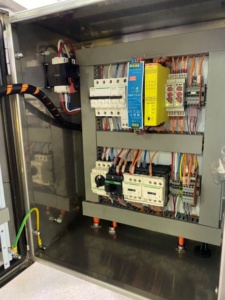


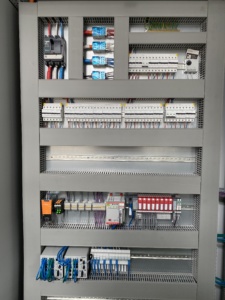

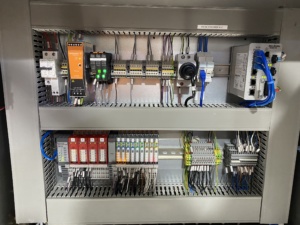
Regular electrical fault finding for your industrial enterprise will save you time and money as your electrical systems start malfunctioning over time. This is because regular maintenance ensures problems are found early, saving you headaches in the long run.
Consequently, electrical fault finding requires a person with specialised knowledge to pinpoint the fault in an electrical system.
Many advantages come with accurately detecting faults in industrial electrical equipment. For one, this can go a long way in preventing the complete breakdown of the electrical installation.
This article will be taking a close look at electrical fault finding. Specifically, this will cover what it means for an electrical circuit not to work and how to find a faulty electrical circuit. If you need help identifying an electrical fault for your business, contact us today.
5 Steps to Finding Faults in an Electrical Circuit
Here are the 5 steps to finding a fault in an electrical circuit:
#1. Turn off All Circuit Breakers
When there is an electrical fault, the main switch in your fuse box will usually trip (this is generally the large red switch or should at least be labelled as such). In this situation, the first step in finding the fault should be turning off all the other circuit breakers as well.
#2. Turn on the Main Switch
After all the other circuit breakers are off, the next step is to turn the main switch back on again. This will not restore power to your home as all of the other circuit breakers should remain turned off.
#3. Switch on the Circuit Breakers One by One
To detect the fault’s area, switch on the circuit breakers one by one, remembering to turn off the previous one as you work your way through them. When doing this, the circuit breaker for the faulty circuit should trip the main switch back off. Typically, circuit breakers trip due to a power surge/excessive current or a defective component. Performing this step helps narrow down which section of the house it is coming from.
#4. Turn off Circuit Breakers
Turning off all circuit breakers again is the next line of action after the identification of the affected circuit breaker.
#5. Turn the Main Switch and Functioning Circuit Breakers Back On
Now you can turn the main switch and other functioning circuit breakers back on. However, the compromised breaker should remain off until you have resolved the issue or contacted a professional electrician.
A power surge can often be why an industrial electrical circuit stops working, especially if it has no circuit breaker.
An excessive electrical current can cause the components of a circuit to overheat, eventually leading to a fire or an explosion. A circuit breaker prevents this from interrupting the excessive electric current flowing through the course into an electrical installation.
Consequently, this protects the circuit, including the industrial equipment, from getting damaged.
What to Do if an Electrical Circuit Is Not Working
It takes a professional electrical engineer to precisely determine the part of an industrial electrical installation that is faulty. This is because a professional industrial electrician has the experience and tools required.
However, there are some steps that a non-professional can follow, especially when trying to find a faulty electrical circuit.
This will help prevent further damage to the industrial electrical equipment and reduce the risk of fire and electrocution.
General Causes of Electrical Faults
There are several reasons for industrial electrical faults. These are some of the general reasons:
#1. Poor Wiring
Poor wiring is one of the main reasons for electrical faults in industries. That is why hiring a professional industrial electrician for any electrical installation is essential.
#2. Overheating
Some electrical appliances can generate so much heat that, over time, they tend to malfunction if left unchecked. One of the ways to counter the excessive heat generated by an appliance is through the use of heat-dissipating systems and regular maintenance.
#3. Improper Installation
Failing to follow the manufacturer’s installation guide can lead to an industrial electrical fault. However, not just any electrician can thoroughly follow the manufacturer’s manual when installing industrial equipment. It takes a professional industrial electrician to install industrial equipment accurately.
#4. Overloading
An electrical fault can also occur when many appliances are connected to a particular circuit. Specifically, this will overload the circuit and cause it to overheat when the demand exceeds what it can produce. When a circuit overheats, it can damage the devices connected to it and even lead to a fire.
Ways to Prevent an Industrial Electrical Fault
Knowing the steps to prevent and diagnose an industrial electrical fault can help reduce the chances of it happening.
A professional industrial electrician can carry out the correct installation of all industrial electrical equipment. Consequently, this will eliminate situations where a circuit has too many appliances attached to it.
Contact a Professional Industrial Electrician
At Industrial Power and Automation, we have a team of experienced industrial electricians with the necessary tools to provide any industrial electrical service. This involves electrical fault finding, whether in an industrial machine or a programmable logic controller (PLC).
With over 30 years of experience, we have built a name for ourselves in Brisbane and the Gold Coast. We pride ourselves on making use of the most current knowledge on electrical installation and repair technology.
Contact us today to get the best industrial electrical services both in Brisbane and Gold Coast.
Electrical preventive maintenance refers to regular maintenance work done on electrical assets at set intervals to repair signs of wear before they lead to breakdowns.
Preventive maintenance is a popular system that many businesses, companies, and organizations use to schedule maintenance tasks that help assets, machinery, electrical panels, and other equipment stay in good, working condition. Preventive maintenance tasks are usually scheduled-based on time or equipment usage.
Performing preventive maintenance prolongs the life of your assets and equipment, reduces downtime, decreases reactive maintenance calls, helps you manage compliance, and prevents costly emergency repairs from occurring.
The failure rate of electrical equipment is three times higher for components that are not part of a scheduled preventive maintenance program as compared with those that are. In addition, a planned electrical preventive maintenance program allows the equipment owner to schedule the system outage at a time of their choosing rather than having to correct major problems resulting from an always untimely failure.
Electrical preventive maintenance offers a variety of benefits:
- Less equipment downtime
- Fewer interruptions to critical operations
- Longer asset life
- Improved efficiency
- Increased workplace safety and improved compliance with OSHA
Switchboard Preventive Maintenance
Enclosure
Ensure that all enclosure panels, doors, and structures are well-maintained in accordance with the manufacturer’s specifications. During de-energized maintenance, enclosures are to be vacuum cleaned of all loose dirt and debris. Any build-up of dirt or other contaminants that will not come off with vacuuming should be cleaned with lint-free rags using cleaning solvents recommended by the manufacturer.
All vents and fan grills are to be cleaned of all dust and/or dirt accumulations. Ensure that ventilation openings are not obstructed. Where seals and/or gaskets are installed, these should be examined and repaired or replaced as necessary. All doors and access panels should be properly secured during operation. Where heater elements are installed, these should be cleaned, examined for damage and/or deterioration, and tested. Repair or replace heater elements as necessary.
Electrical equipment rooms should be kept clean of dirt and dust accumulation on a regular basis. Doors and windows should be maintained in proper working order and kept closed during routine operations. Access doors should be clearly marked to alert personnel that live electrical equipment is in use. Where ventilation or air conditioning is used, all fan motors should be cleaned and examined for signs of wear deterioration. Fan blades should be cleaned of dirt and dust and bearings should be properly lubricated. Vent openings should be cleaned of all dust and dirt accumulation. Filters should be cleaned or changed as recommended by the manufacturer, or more often if conditions warrant. Electrical equipment rooms should never be used as storage areas.
Conductors
Examine insulation for signs of deterioration, cracking, flaking, or overheating. Examine all connections for signs of overheating, cracked or broken connectors, and signs of tracking or arcing. Ensure that conductors are clean and dry. Examine and clean all connections, and torque to manufacturer’s recommendations.
Bus System
Bus duct joint covers should be removed to allow access for a thermographic survey of the energized bus under load. After de-energizing, connections should be checked for proper tightness as well as evidence of overheating, corrosion, arcing, or other forms of deterioration. All loose or dirty connections should be cleaned and properly torqued. The tops of the bus duct enclosure should be inspected for evidence of water or other foreign matter that may contaminate the bus duct.
Control Panel Preventive Maintenance
Visual and Mechanical Inspection
Inspect relays for physical damage and deterioration. Inspect gaskets and covers for damage and/or excessive wear, and repair or replace as necessary. Examine and clean the relay and enclosure of foreign materials, such as dust, dirt, and moisture contamination. Examine the condition of the spiral spring, disc clearances, contacts, and case shorting contacts (if present). Check mechanism for freedom of movement, proper travel and alignment, and tightness of mounting hardware and plugs.
Insulation, Supports and Connectors
Inspect insulators and conductor supports for signs of cracking, broken pieces, and other physical damage or deterioration. Clean all loose dirt with lint-free rags. For contaminates that will not remove easily, solvents approved by the manufacturer may be used. Examine for evidence of moisture that may lead to tracking or flashover while in operation. Examine surrounding areas for signs of tracking, arcing, or overheating. Repair or replace damaged insulators and supports as necessary. Examine all bolts and connecting devices for signs of deterioration, corrosion, or overheating. Ensure that bolts and connecting devices are tight, according to manufacturer’s specifications.
Electric Motor Preventive Maintenance
Visual Inspection
A visual inspection should look for:
• Evidence of damage caused by dirt, loose parts, or foreign objects
• Verification that air inlets are not blocked
• Evidence of moisture and/or dirt build-up
• Unusual noises, leaking oil seals, or high vibration
• Oil level gauges (if present) should be checked
• Evidence of degradation of foundation, bed plates, and anchor bolts
• Evidence of leaking oil and water piping and connections
Insulation resistance (IR)
Perform IR check between motor windings, and between the windings and ground. This determines condition of the motor winding insulation.
Running Current
Record and trend all three phase currents and verify the currents are balanced and do not exceed nameplate rating. Each phase should be within +/- 5% of the average of all three phases.
Thermal Imaging (Infrared inspection)
An infrared, or thermographic inspection should be performed at least once every year on all switchgear, distribution panels, cable and bus connections, motor control centers, and other critical equipment.
Thermal imaging is a non-invasive, low-cost diagnostic technique that allows us to visually inspect and quantify changes in the surface temperature of electrical equipment. It is an effective method of protecting your business’s assets and giving you peace of mind. Thermal Imaging is an essential part of every commercial and industrial business’s preventative maintenance plan.
Abnormal heating associated with high resistance or excessive current flow is the main cause of many problems in electrical systems. When current flows through an electric circuit, part of the electrical energy is converted into heat energy. But if there is an abnormally high resistance in the circuit or abnormally high current flow, high heat is generated which can be potentially damaging.
Unidentified hazards and equipment faults can lead to equipment failure, loss in electricity supply or electrical fire. Insurance companies often recommend that Thermal Imaging is undertaken on an annual basis, and often offer lower premiums to businesses who schedule regular Thermal Imaging tests.
Industrial Electrical Preventive Maintenance Gold Coast
Industrial Power and Automation provides an extensive range of electrical preventive maintenance services for our clients. We can schedule maintenance services based on your budget, needs and compliance requirements. Our management software can log your assets and keep a detailed record of their service history, as well as send reminders when the next inspection is due, leaving you to focus on what’s important.
You can contact us today, and rest assured that you will get the best electrical services no matter your industry.
This article looks at the differences and similarities between industrial vs commercial electricians.
There is a common misconception that there is no difference between an industrial electrician and a commercial electrician, however, this isn’t really true.
Every electrician ends up specialising in one area during their training. As such, employing the right one for the job can go a long way in helping you get your desired results.
With all that out the way, let’s look at each in a little more detail.
What Does a Commercial Electrician Do?
A commercial electrician specialises in providing electrical services to commercial businesses such as restaurants and retail stores. Specifically, the services involve electrical repairs/maintenance, installations and safety inspections.
Not only that, a commercial electrician can help draw diagrams or plans that satisfy the needs of a client-facing business.
Tasks of a Commercial Electrician
There are several common tasks that a commercial electrician takes care of. These include:
- Wiring of commercial buildings and electrical appliances in line with local, state and national guidelines.
- Reading and effectively using blueprints, schematics and several other technical drawings in providing electrical services.
- Ability to pinpoint technical electrical problems in a commercial building, analyse the situation and develop the most effective solution.
- Repair electrical equipment and systems.
- Install electrical appliances in a commercial building per the manufacturer’s regulations.
- Capability to test electrical equipment to determine if it is in good condition.
- Being able to supply proper documentation as regards repairs, replacement and servicing.
Skills of a Commercial Electrician
- Ability to think critically and technically as most of the duties of commercial electricians involve accurately detecting electrical issues.
- Being able to communicate properly with clients and coworkers so as to satisfy clients.
- Resourcefulness to bring up new ideas that can help solve a unique electrical fault.
- Ability to appear and work in a professional manner in line with the code of conduct for commercial electricians.
What it Takes to Become a Commercial Electrician
Specific requirements exist before a person can claim to be a commercial electrician. For a start, an individual will need to obtain a qualification in electrotechnology.
After this, they will have to acquire a minimum of 12 months of experience working in the field. Upon completing the work experience, they can apply for an electrician license and start practicing once that has been approved.
What Does an Industrial Electrician Do?
An industrial electrician is a professional that deals mainly with installing, repairing, maintaining and inspecting industrial electrical equipment such as the different parts of a hydroelectric power plant or a wind power system.
Examples of places where industrial electricians are best suited to work are mines, factories, and manufacturing plants.
Tasks of an Industrial Electrician
An industrial electrician may need to perform the following tasks:
- Repairs and proper maintenance of equipment meant for the manufacturing and production processes.
- Testing electrical devices to determine if there are any faults and how to resolve them or if there is a need for an upgrade.
- Installation of electrical outlets and other electrical appliances that are necessary for the manufacturing process.
- Cleaning/repairing and wiring electronic circuit boards.
- Setting up, servicing or repairing heavy-duty electronic equipment and industrial systems for electrical communication.
- Drawing or following a blueprint or schematic to solve a problem.
Skills of an Industrial Electrician
Some skills are essential for an industrial electrician to have. An industrial electrician should have:
- A good grasp of how different parts connected to an electrical source operate.
- The skill to analyse and detect the source of an electrical problem and provide solutions to the problem.
- The ability to work with others as a team based on strong interpersonal skills.
- Great communication skills. This demands being able to read and comprehend texts such as manuals and technical codes. It also means having what it takes to listen and speak with clarity.
- The ability to pay attention to details and avoid mistakes.
- Excellent time management skills and the capacity to organise people into groups to carry out different tasks.
- The skill to perform physically demanding tasks.
What it Takes to Become an Industrial Electrician
Before a person can work as an industrial electrician, they must undergo extensive training.
This will require seeking and applying for an electrical apprenticeship under a registered training institute which could last up to four years. Subsequently, upon completion, an individual will receive a certification in electrotechnology.
After acquiring this, you still need an electrician’s licence before you can practice.
The Difference Between Commercial and Industrial Electricians
Although industrial and commercial electricians share certain similarities, some key aspects set them apart. The differences are:
#1. Different Work Environments
Commercial electricians deal with the electrics in commercial, public-facing buildings. On the other hand, industrial electricians focus on the electrics within an industrial environment.
#2. The Tools Used
Commercial electricians make use of tools that are usually simpler and more in line with what most of us have in our homes. On the flip side, industrial electricians often use specialised tools suited to industrial electrical equipment.
#3. Voltage
Industrial electricians usually work with higher voltages.
#4. The Training Received
Industrial engineers’ training is usually more extensive than the training for commercial electricians. This is because the risks and hazards are generally more extreme than those encountered in a commercial setting.
At IPA Solutions, We Do Both
At IPA Solutions, we have a team of both commercial and industrial electrical experts who specialise in handling an extensive range of industrial and commercial electrical services.
You can contact us today, and rest assured that you will get the best electrical services no matter your industry.
